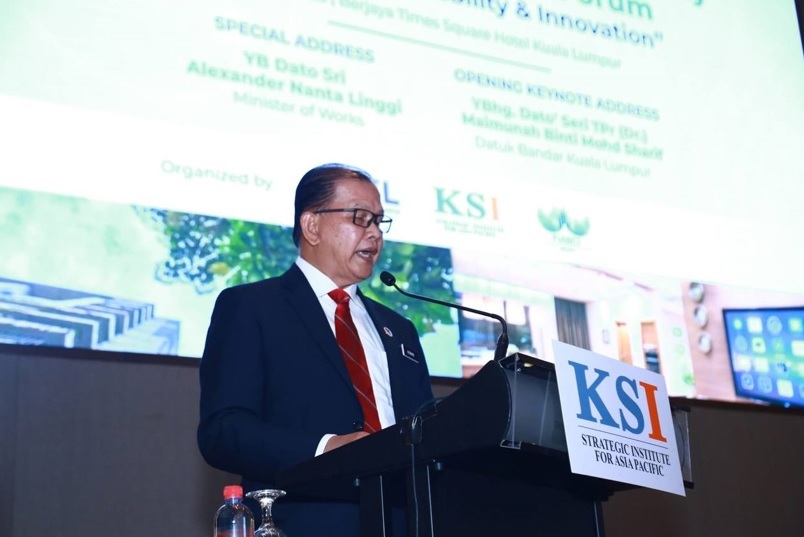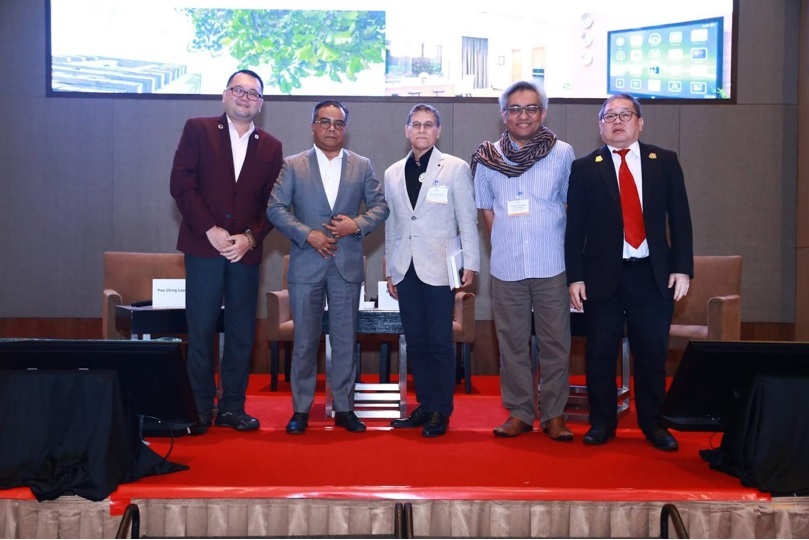
- “In essence, smart construction, while leveraging technology and data to optimise resource use, reduce waste, and minimise environmental impact, will ultimately lead to more sustainable buildings and construction practices.”
PETALING JAYA (May 20): The construction sector produces approximately 38% of global carbon emissions and 24% in Malaysia, making it a critical focus for climate action in the push toward national carbon neutrality by 2050, said Works Minister Datuk Seri Alexander Nanta Linggi.
Therefore, Nanta said smart construction represents a paradigm shift from traditional building methods toward practices that minimise environmental impact while maximising social and economic benefits.
“This approach encompasses the entire lifecycle of buildings and infrastructure from design and material selection to construction, operation, maintenance and eventual demolition or repurposing.
“In essence, smart construction, while leveraging technology and data to optimise resource use, reduce waste, and minimise environmental impact, will ultimately lead to more sustainable buildings and construction practices,” he said in a speech during the Smart Housing, Sustainable Property and Innovative Cities Forum at the Berjaya Times Square Hotel, Kuala Lumpur.
Nanta’s speech was delivered by Works Ministry secretary-general Datuk Seri Azman Ibrahim.
He explained that one of the country’s strategies lies in developing smart infrastructure to meet Malaysia’s evolving needs. With over RM400 billion expected to be invested in infrastructure by 2030, sustainability and technological innovation must go hand in hand.
“These investments must not only address growing demands but also reflect a forward-thinking, tech-driven approach to infrastructure,” he said.
Smart city initiatives under the Malaysia Smart City Framework are already pushing for green buildings, smart homes and automated transport systems.
“Through the Construction Industry Development Board’s (CIDB) Construction 4.0 Strategic Plan, the industry has been transitioning from conventional methods to smart construction,” Nanta revealed.
This includes rolling out innovations like Digital Twin Technology for predictive maintenance, IoT-enabled infrastructure such as sensor-equipped bridges and smart lighting, artificial intelligence (AI)-powered maintenance systems, and climate-resilient designs that embed nature-based and self-healing materials.
“We are hopeful to garner the essential support not just from relevant government agencies but, more importantly, from the industry community, especially in creating and driving the transformative changes.
“The ESG framework and roadmap for the construction sector is expected to be finalised this year,” Nanta said.

Digitise or be left behind in the AI revolution
Meanwhile, Yes Boss Corporation general manager Ts Poo Ching Loong said Malaysia must act quickly to embrace digitisation and AI, warning that failure to do so means missing out on the current industrial revolution.
“If we don't pick up in this era, we need to wait for the next industrial revolution,” he said.
While praising the government's focus on data centres, he said infrastructure alone isn't enough and stressed the need to digitise the real estate industry, which still relies heavily on physical documents.
“Once data is digitised, the next step is to keep and structure it properly, treating it as an asset.
“This asset will determine how far you can go,” Poo said.
AI—real disruptor in architecture and property
Veritas Design Group founder, president and director David Mizan Hashim said the biggest disruption in the property development industry today is AI.
Previously, he outlined five key digital trends: big data, social media, smart homes, smart cities, and BIM. But none of them, he admitted, have the same transformative impact that AI now has on design, planning, and marketing in architecture.
Today, he said, forward-thinking firms are using AI across three major areas: generative design, 3D visualisation and copywriting.
“We don't design car parks anymore. The AI designs our car parks.
“Makes them very efficient, suggests different ramps, locations. All this is done in literally minutes,” he said during the “Innovation and Technology in Property—How AI will Benefit and Impact Housing and Property Development” session.
But he also warned that AI isn’t perfect. “It doesn’t get it right all the time. Just like ChatGPT, it hallucinates,” he said.
Smart buildings need smarter curriculum and better user experience
Pertubuhan Akitek Malaysia (PAM) Housing and Wellbeing Urban Committee member Ar Mustapha Kamal Zulkarnain called for curriculum reform.
“In Malaysia, we need a curriculum about smart buildings. Most of the time, the system integrator is the person who knows the building well, probably the architect,” he said.
He also flagged the importance of user experience in smart infrastructure.
“Colours, smell, touch, hearing they’re crucial for you to work better in a building, not just longer.
“It has to be a better life, not just longer hours,” he added.
AI boosts sales, speed, and efficiency in property
W Straits Limited chairman and president Prof Major (H) Datuk Dr Ir Ts Br Chin Yew Sin, JP, explained how AI can support the real estate industry. From virtual tours that help property agents sell homes during lockdowns, to AI-based valuation tools that speed up price assessments, the technology boosts efficiency and sales.
“During Covid-19, you can’t go out so, the virtual tour is very good. It can increase sales by 20%, according to a study.
“AI can process a lot of data and keep upgrading its efficiency, as it can come up with the valuation of the property very fast,” he said.

Rethinking affordable housing policy and planning
Moreover, during “The Affordable Housing Conundrum—What More Can Be Done?” session, Khazanah Research Institute (KRI) research associate Dr Nur Fareza Mustapha said housing policy needs a total reset to one that puts the risk back on developers, not buyers.
“What we've been doing is artificially boosting demand. It’s not sustainable,” she said.
She pushed for a “build then sell” model, where developers only sell completed homes.
“Only then can the market work efficiently,” she explained.
Rahim & Co International Sdn Bhd chief executive officer Siva Shanker mentioned that so-called affordable homes aren’t selling because they’re not truly affordable or in the right places.
“Thousands of ‘affordable’ houses are unsold. Are they then perhaps not affordable?”
He blamed poor location, bad definitions, and weak financing.
“If we can't even define what affordable is, then we don't even know where to start,” he stated.
Zerin Properties Corporate Valuers Sdn Bhd Research and Consultancy head Roja Rani Applanaidu called for grassroots engagement and localised data on income, family size, and migration trends.
“Without data-driven planning, states risk continuing to build homes that people either don’t want or can’t access.
“Homebuyers today don’t want just barebones flats; they want third places such as green courtyards, multi-use courts, even pickleball facilities,” she explained.
Want to have a more personalised and easier house hunting experience? Get the EdgeProp Malaysia App now.

senaiairportcity-overallview.jpg?wyCmw4_M_WK1b.OkWEhqLZeyUgCmSweP)



